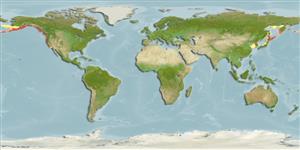>
Perciformes/Cottoidei (Sculpins) >
Cottidae (Sculpins)
Etymology: Leptocottus: Greek, leptos = thin + Greek, kottos = a fish (Ref. 45335); armatus: Leptocottus meaning slender Cottus; armatus armed, referrign to the sharp preopercular spines (Ref. 4930).
More on author: Girard.
Environment: milieu / climate zone / depth range / distribution range
ນິເວດວິທະຍາ
ສັດທະເລ; ນ້ຳກ່ອຍ ອາໄສຢູ່ໃກ້ໜ້າດິນໃຕ້ພື້ນທ້ອງນ້ຳ; ປາທີ່ມີການເຄື່ອນຍ້າຍຈາກທະເລໄປຫານ້ຳຈືດ ແລະນ້ຳຈືດຫາທະເລ (Ref. 51243); ລະດັບຄວາມເລິກ 0 - 156 m. Temperate; 60°N - 33°N
Eastern Pacific: Izembek Lagoon, on the southeastern Bering Sea coast of Alaska to Bahia San Quintin, northern Baja California, Mexico.
ຂະໜາດ / ນ້ຳໜັກ / Age
Maturity: Lm ? range ? - ? cm
Max length : 46.0 cm TL ຕົວຜູ້/ບໍ່ມີເພດ; (Ref. 2850); common length : 35.5 cm TL ຕົວຜູ້/ບໍ່ມີເພດ; (Ref. 12193); ອາຍຸສູງສຸດທີ່ເຄຍລາຍງານມາ: 10 ປີ (Ref. 28936)
ຄີ (ໜາມ)ແຂງຢູ່ຫຼັງປາ (ທັງໝົດ): 6 - 8; ຄີຫຼັງຂອງປາ (ຄີອ່ອນ) (ທັງໝົດ): 15-20; ຄີ(ໜາມ) ແຂງຢູ່ຄີກົ້ນປາ
ກຸ່ມປາກະດູກແຂງ
ຄວາມຖີ່ຂອງກຸ່ມຖ່າຍທອດພັນ
ປາທີ່ມີການເຄື່ອນຍ້າຍຈາກທະເລໄປຫານ້ຳຈືດ ແລະນ້ຳຈືດຫາທະເລ
ປາທີ່ມີການເຄື່ອນຍ້າຍຈາກທະເລແລະໄປໄຂ່ຢູ່ນ້ຳຈືດ
ຄີກົ້ນຂອງປາ
ສັດທີ່ມີກະດູກສັນຫັຼງ
ການຖ່າຍທອດທາງກຳມະພັນຈາກພໍ່ແມ່ຫາລູກ 0; ຄີກົ້ນຂອງປາ: 15 - 20; ສັດທີ່ມີກະດູກສັນຫຼັງ: 37 - 39. Distinguished by the large upper preopercular spine ending in 3 or 4 sharp, upturned, curved spinules and by the large, dark spot on the posterior part of the spiny dorsal fin (Ref. 27547). Gill rakers reduced to flat, bony plates, each bearing a cluster of small teeth; lateral line nearly straight; each pore associated with a small subdermal cartilaginous plate (Ref. 27547). Caudal rounded (Ref. 6885). Grayish olive to rather green, occasionally with some yellow, dorsally; orange-yellow to white or silvery below lateral line; spiny dorsal dusky, with a black spot near tips of last 3 spines, a white band below it; soft dorsal fin dusky, with several oblique white to yellowish bands; pectorals yellow with 5 or 6 dark greenish bars; caudal dusky with one or two pale bands; anal and pelvic fins pale (Ref. 27547).
Commonly found near shore, especially in bays and estuaries; most frequently on sandy bottom (Ref. 2850). Intertidal individuals breath air when out of water (Ref. 31184). Can leave tide pools if aquatic conditions become inhospitable (Ref. 31184). Although some individuals may spend their entire life in highly saline waters (Ref. 28693), some newly metamorphosed young move from the estuarine spawning sites to completely fresh water and may remain there for up to 6 weeks (Ref. 27547). Adults apparently tend to remain in the shallow lower estuary, or farther offshore (Ref. 27547). Feeds mostly on crabs, shrimps and amphipods, but also takes larval, juvenile and adult fishes, as well as polychaete worms, mollusks and other invertebrates (Ref. 4930). Expands its gill covers and produces a low-pitched humming sound when stressed (Ref. 6885). Considered a nuisance by anglers (Ref. 27547).
Eschmeyer, W.N., E.S. Herald and H. Hammann, 1983. A field guide to Pacific coast fishes of North America. Boston (MA, USA): Houghton Mifflin Company. xii+336 p. (Ref. 2850)
IUCN Red List Status (Ref. 130435)
Threat to humans
Harmless
Human uses
ຕູ້ປາ: ບ່ອນວາງສະແດງສັນນ້ຳຂອງລັດ
ຂໍ້ມູນຕື່ມອີກ
ເອກະສານອ້າງອີງການລ້ຽງສັດນ້ຳຂໍ້ມູນການລ້ຽງສັດນ້ຳສາຍພັນກຳມະພັນElectrophoresesການຖ່າຍທອດທາງກຳມະພັນຈາກພໍ່ແມ່ຫາລູກພະຍາດການປຸງແຕ່ງNutrientsMass conversion
ຜູ້ຮ່ວມມືຮູບStamps, Coins Misc.ສຽງຫອຍມີພິດຊະນິດນຶ່ງທີ່ອາໄສໃນທະເລຄວາມໄວປະເພດການລອຍເນື້ອທີ່ເຫືອກOtolithsສະໝອງວິໄສທັດ
ເຄື່ອງມື
Special reports
Download XML
ແຫຼ່ງອີນເຕີເນັດ
Estimates based on models
Preferred temperature (Ref.
123201): 4.5 - 14.1, mean 8.7 °C (based on 352 cells).
Phylogenetic diversity index (Ref.
82804): PD
50 = 1.0000 [Uniqueness, from 0.5 = low to 2.0 = high].
Bayesian length-weight: a=0.01023 (0.00518 - 0.02023), b=3.19 (3.01 - 3.37), in cm total length, based on LWR estimates for this species & (Sub)family-body (Ref.
93245).
ຊັ້ນເຂດຮ້ອນ (Ref.
69278): 3.7 ±0.64 se; based on food items.
ຄວາມຢືດຢຸ່ນ (Ref.
120179): ຂະໜາດກາງ, ປະຊາກອນຕຳ່ສຸດທີ່ໃຊ້ເວລາສອງເທົ່າ 1.4 - 4.4 ປີ (tm=1; tmax=10).
Fishing Vulnerability (Ref.
59153): Moderate vulnerability (36 of 100).
Nutrients (Ref.
124155): Calcium = 66.7 [29.5, 146.1] mg/100g; Iron = 0.418 [0.197, 0.881] mg/100g; Protein = 18.1 [16.0, 20.3] %; Omega3 = 0.668 [0.293, 1.935] g/100g; Selenium = 18.9 [8.9, 45.8] μg/100g; VitaminA = 8.11 [2.78, 24.42] μg/100g; Zinc = 0.618 [0.413, 1.057] mg/100g (wet weight);
